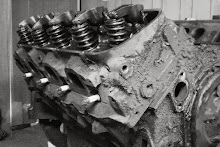I think at this point the blog is basically caught up to the point where I was ready to start the engine ... wiring was done, radiator in place, fuel plumbed, etc. The hydraulic clutch conversion was plumbed and bled, the driveshaft was installed. Logos and numbers were painted on various parts purely for decoration, steering wheel was wrapped in electrical tape. You know, all the important stuff was done.
Probably the worst thing about being so far behind on blog updates is that by the time I get around to writing about something that happened, I've forgotten a lot of the details of what actually happened. The first engine start was May 6, 2017, which is almost a year ago now. At this point, in hindsight, it seems like everything went relatively smoothly, without much of a story to tell, but at the time I think it seemed more eventful.
It's always good to have another set of eyes/ears/hands for a first engine start, and fortunately my buddy Allen was able to come down from Austin to help out. I had already added coolant and oil during the previous week, and that morning we put a couple gallons of 93 octane in the tank, then also filled the carburetor float bowls by squirting gasoline down the vents. We took the car off the jackstands that it had been sitting on for over a year and set it on the floor.
After it was on the floor, we rolled the car back until the rear wheels were right at the edge of the garage door. I wanted to get the exhaust exits as close to the garage door as possible, to try to minimize the accumulation of exhaust in the garage. We set up a couple of fans, one at the front of the car and one at the rear. I wanted to move air to the radiator, and try to get some airflow to carry the exhaust outside as much as possible.
I had taken the shaft out of the old distributor from the Monte Carlo and removed the gear, to turn it into a priming tool so that I could use an electric drill to drive the oil pump and prime the oil circuit. After running the drill with the priming tool long enough to verify oil pressure on the gauge in the dashboard and pump oil up to the valvetrain, I rechecked the oil level to make sure it hadn't dropped too much when the oil filter filled up. After that, I installed the distributor and spark plug wires, then hooked up my timing light. At that point, we were pretty much ready to crank.
The first cranking attempt revealed several fuel leaks, and we found that I'd left all the fuel lines between the pump and the carburetor only hand-tight. A stupid mistake, but easy to fix, which is always nice.
After tightening up the fuel connections, the engine would crank with no leaks, but still wouldn't start after several tries. We had filled the float bowls with gasoline before cranking, and we had fuel in the in-line fuel filter just before the carburetor inlet, and fuel pressure on the gauge at the carb inlet. Fuel did not appear to be the problem, which left spark as the most likely problem.
Allen wanted to have one of us try turning the distributor to adjust spark while the other one cranked the engine, and in hindsight, that probably would have worked fine, and probably more quickly than what we ended up doing. But we didn't know if we needed to advance timing or retard it, and I didn't want to be turning the distributor further and further in the wrong direction if we started going the wrong way. Realistically, it probably wouldn't have been a problem, and probably the worst thing we might have done would have been to have a backfire start a small fuel fire on the carburetor, which I think we ended up doing at some point, anyway.
If I remember correctly, which I might not, I think what we ended up doing was using the timing light while cranking to try to check timing, found out timing was retarded quite a bit, advanced timing, tried cranking again, and eventually the engine started. Once the engine was running, we could set timing properly. After that, it was just a question of holding engine speed up around 2000rpm for 15-20min. to break in the camshaft. The gas pedal was a little touchy, and it took a few tries to find the "sweet spot" where I could hold the engine speed where I wanted it. Actually, it still is a little touchy, but I have a plan to fix that, and there will be more on that in some other blog update in the indeterminate future. I already linked to it in another blog entry, but there is some audio of the engine running during cam break-in here.
My check list for after the engine was running included setting timing (done), checking for leaks (didn't see any), checking that the choke opened (it did), checking accessory belt tension (appeared to be good), and checking the coolant level. I'd left the radiator cap loose so that we could check to see if the cooling system "burped" to let out any air pockets that might have been trapped in the engine, which would have caused the coolant level to go down. It appeared that it might have dropped a little bit, but not any more than might be expected. So all that looked pretty good.
The other thing on the list was to verify that the alternator was charging. The "GEN" warning light that I had wired in was dimly lit the whole time through the cam break-in, but the voltmeter appeared to show around thirteen volts. I wasn't 100% sure that I'd wired the warning light correctly, so I assumed that it must not be wired correctly, since the voltmeter seemed to indicate that the system was working.
After the cam break-in time was finished, I dropped the engine speed to idle and decided to see if I could move the car forward into the garage under its own power. But, when I pushed in the clutch and tried to put the transmission in gear, all I got was a grinding of gears that didn't sound good at all. After a couple more tries, I shut off the car and we pushed it back into the garage. That was a little disappointing, but not shocking, as I'd already been unsure whether or not the hydraulic clutch was working correctly.
I don't remember for sure the exact sequence of events, but we eventually determined that the charging system wasn't working after all. I think Allen saw the warning light and maybe had more faith in my wiring than I did, so I think maybe he suggested that we should check the alternator output with a voltmeter. At idle, the voltmeter only showed about twelve volts. If I ran the engine speed back up to around 2000rpm, the voltage would increase to around thirteen volts, but the alternator was clearly not charging like it should at idle.
At that point, I really just wanted to savor the successful completion of the cam break-in and not think about my new problems, so we put away the tools, closed the garage door, and went inside to celebrate with some champagne (of beers).
After sitting around for a little while, though, I decided maybe I should start studying the wiring for the voltage regulator and the charging system in general. Looking through it a little bit, I noticed that the diagram showed the body of the voltage regulator being grounded. There didn't appear to be any specific wire connection for that, so I assumed that it was supposed to ground through its mounting to the radiator core support. However, because of the way I'd mounted the voltage regulator using rubber grommets, it was not properly grounded through its mounting.
I didn't really think that grounding the voltage regulator body would fix the charging problem, but sometimes you just have to start fixing everything that might be wrong, and hope that one of the things ends up being the fix. Anyway, I already had a couple extra ground straps laying around, so I just threw one on one of the voltage regulator mounting bolts, and then bolted the other end to the radiator core support, after checking that the bolt I was using had a good connection to the battery ground.
I started the car up again, and to my amazement, the "GEN" light went out and the voltmeter showed almost fourteen volts. So by that time, the first fire and cam break-in had been completed, and I'd discovered that the clutch didn't work and the charging system wasn't charging, but I'd already fixed the charging issue. All in all, a very successful day.
Unfortunately, later that night I would go out to the garage to have a little look-around, and I would notice a couple of puddles on the floor under the engine. One turned out to be engine oil that had run down the side of the engine and dripped onto the floor after leaking past the passenger side rocker cover gasket. I hadn't tightened the rocker covers down well enough, so it was an easy fix to just torque those bolts a little bit.
The other puddle turned out to be coolant. And that will be a whole other story.
Wednesday, April 04, 2018
Subscribe to:
Posts (Atom)






